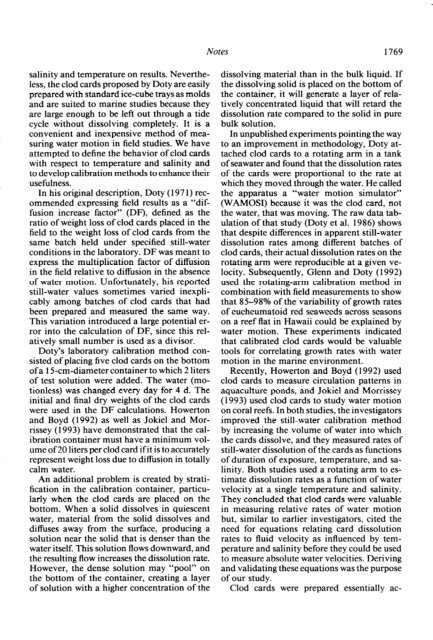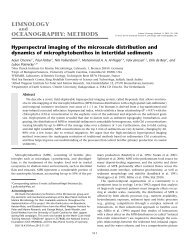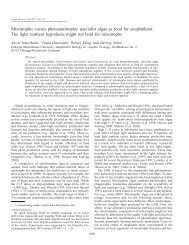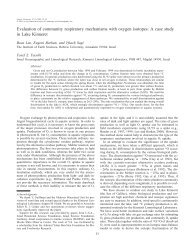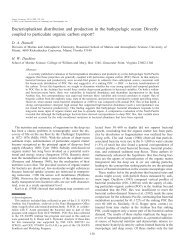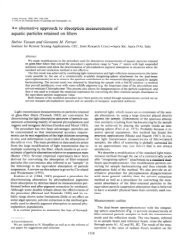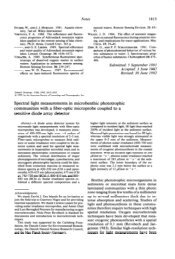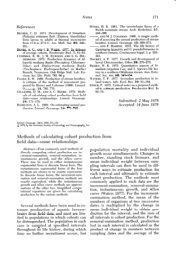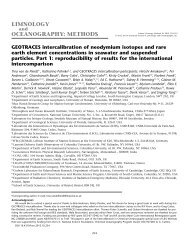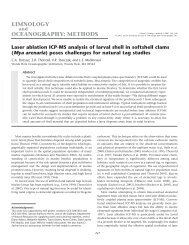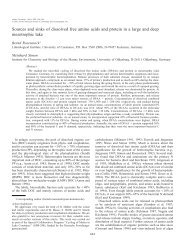Download - ASLO
Download - ASLO
Download - ASLO
You also want an ePaper? Increase the reach of your titles
YUMPU automatically turns print PDFs into web optimized ePapers that Google loves.
Notes 1769<br />
salinity and temperature on results. Nevertheless,<br />
the clod cards proposed by Doty are easily<br />
prepared with standard ice-cube trays as molds<br />
and are suited to marine studies because they<br />
are large enough to be left out through a tide<br />
cycle without dissolving completely. It is a<br />
convenient and inexpensive method of measuring<br />
water motion in field studies. We have<br />
attempted to define the behavior of clod cards<br />
with respect to temperature and salinity and<br />
to develop calibration methods to enhance their<br />
usefulness.<br />
In his original description, Doty (197 1) recommended<br />
expressing field results as a “diffusion<br />
increase factor” (DF), defined as the<br />
ratio of weight loss of clod cards placed in the<br />
field to the weight loss of clod cards from the<br />
same batch held under specified still-water<br />
conditions in the laboratory. DF was meant to<br />
express the multiplication factor of diffusion<br />
in the field relative to diffusion in the absence<br />
of water motion. Unfortunately, his reported<br />
still-water values sometimes varied inexplicably<br />
among batches of clod cards that had<br />
been prepared and measured the same way.<br />
This variation introduced a large potential error<br />
into the calculation of DF, since this relatively<br />
small number is used as a divisor.<br />
Doty’s laboratory calibration method consisted<br />
of placing five clod cards on the bottom<br />
of a 15-cm-diameter container to which 2 liters<br />
of test solution were added. The water (motionless)<br />
was changed every day for 4 d. The<br />
initial and final dry weights of the clod cards<br />
were used in the DF calculations. Howerton<br />
and Boyd (1992) as well as Jokiel and Morrissey<br />
(1993) have demonstrated that the calibration<br />
container must have a minimum volume<br />
of 20 liters per clod card if it is to accurately<br />
represent weight loss due to diffusion in totally<br />
calm water.<br />
An additional problem is created by stratification<br />
in the calibration container, particu-<br />
larly when the clod cards are placed on the<br />
bottom. When a solid dissolves in quiescent<br />
water, material from the solid dissolves and<br />
diffuses away from the surface, producing a<br />
solution near the solid that is denser than the<br />
water itself. This solution flows downward, and<br />
the resulting flow increases the dissolution rate.<br />
However, the dense solution may “pool” on<br />
the bottom of the container, creating a layer<br />
of solution with a higher concentration of the<br />
dissolving material than in the bulk liquid. If<br />
the dissolving solid is placed on the bottom of<br />
the container, it will generate a layer of relatively<br />
concentrated liquid that will retard the<br />
dissolution rate compared to the solid in pure<br />
bulk solution.<br />
In unpublished experiments pointing the way<br />
to an improvement in methodology, Doty attached<br />
clod cards to a rotating arm in a tank<br />
of seawater and found that the dissolution rates<br />
of the cards were proportional to the rate at<br />
which they moved through the water. He called<br />
the apparatus a “water motion simulator”<br />
(WAMOSI) because it was the clod card, not<br />
the water, that was moving. The raw data tabulation<br />
of that study (Doty et al. 1986) shows<br />
that despite differences in apparent still-water<br />
dissolution rates among different batches of<br />
clod cards, their actual dissolution rates on the<br />
rotating arm were reproducible at a given velocity.<br />
Subsequently, Glenn and Doty (1992)<br />
used the rotating-arm calibration method in<br />
combination with field measurements to show<br />
that 85-98% of the variability of growth rates<br />
of eucheumatoid red seaweeds across seasons<br />
on a reef flat in Hawaii could be explained by<br />
water motion. These experiments indicated<br />
that calibrated clod cards would be valuable<br />
tools for correlating growth rates with water<br />
motion in the marine environment.<br />
Recently, Howerton and Boyd (1992) used<br />
clod cards to measure circulation patterns in<br />
aquaculture ponds, and Jokiel and Morrissey<br />
(1993) used clod cards to study water motion<br />
on coral reefs. In both studies, the investigators<br />
improved the still-water calibration method<br />
by increasing the volume of water into which<br />
the cards dissolve, and they measured rates of<br />
still-water dissolution of the cards as functions<br />
of duration of exposure, temperature, and salinity.<br />
Both studies used a rotating arm to estimate<br />
dissolution rates as a function of water<br />
velocity at a single temperature and salinity.<br />
They concluded that clod cards were valuable<br />
in measuring relative rates of water motion<br />
but, similar to earlier investigators, cited the<br />
need for equations relating card dissolution<br />
rates to fluid velocity as influenced by temperature<br />
and salinity before they could be used<br />
to measure absolute water velocities. Deriving<br />
and validating these equations was the purpose<br />
of our study.<br />
Clod cards were prepared essentially ac-


